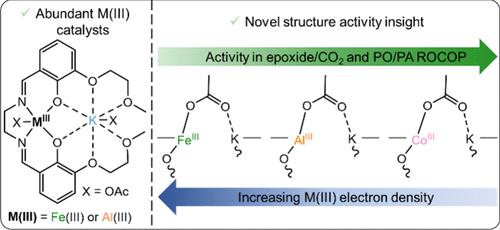当前位置:
X-MOL 学术
›
Inorg. Chem.
›
论文详情
Our official English website, www.x-mol.net, welcomes your
feedback! (Note: you will need to create a separate account there.)
Understanding the Effect of M(III) Choice in Heterodinuclear Polymerization Catalysts
Inorganic Chemistry ( IF 4.3 ) Pub Date : 2024-11-19 , DOI: 10.1021/acs.inorgchem.4c04430 Katharina H.S. Eisenhardt, Francesca Fiorentini, Charlotte K. Williams
Inorganic Chemistry ( IF 4.3 ) Pub Date : 2024-11-19 , DOI: 10.1021/acs.inorgchem.4c04430 Katharina H.S. Eisenhardt, Francesca Fiorentini, Charlotte K. Williams

|
The ring-opening copolymerization (ROCOP) of epoxides with CO2 or anhydrides is a promising strategy to produce sustainable polycarbonates and polyesters. Currently, most catalysts are reliant on scarce and expensive cobalt as the active center, while more abundant aluminum and iron catalysts often suffer from lower activities. Here, two novel heterodinuclear catalysts, featuring abundant Al(III), Fe(III), and K(I) active centers, are synthesized, and their performance in the polymerization of four different monomer combinations is compared to that of their Co(III) analogue. The novel Al(III)K(I) catalyst exhibits outstanding activities in the cyclohexane oxide (CHO)/CO2 ROCOP, and at 1 bar CO2 pressure it is the fastest aluminum-based catalyst reported to date. The M(III) site electronics for all three catalysts, Al(III)K(I), Fe(III)K(I), and Co(III)K(I), are measured using IR and NMR spectroscopy, cyclic voltammetry, and single crystal X-ray diffraction. A correlation between M(III) electron density and catalytic activity is revealed and, based on the established structure–activity relationship, recommendations for the future catalyst design of abundant Al(III)- and Fe(III)-based catalysts are made. The catalytic performances of both Al(III)K(I) and Fe(III)K(I) are further contextualized against the relative elemental abundance and cost. On the balance of performance, abundance, and cost, the Al(III)K(I) complex is the better catalyst for the carbon dioxide/epoxide ROCOP, while Fe(III)K(I) is preferable for anhydride/epoxide ROCOP.
中文翻译:

了解 M(III) 选择在异双核聚合催化剂中的影响
环氧化物与 CO2 或酸酐的开环共聚 (ROCOP) 是生产可持续聚碳酸酯和聚酯的一种很有前途的策略。目前,大多数催化剂都依赖于稀缺且昂贵的钴作为活性中心,而含量更高的铝和铁催化剂往往活性较低。本文合成了两种新型异二核催化剂,具有丰富的 Al(III)、Fe(III) 和 K(I) 活性中心,并将它们在四种不同单体组合的聚合性能与其 Co(III) 类似物的性能进行了比较。新型 Al(III)K(I) 催化剂在环己烷氧化物 (CHO)/CO2 ROCOP 中表现出出色的活性,在 1 bar CO2 压力下,它是迄今为止报道的最快的铝基催化剂。所有三种催化剂 Al(III)K(I)、Fe(III)K(I) 和 Co(III)K(I) 的 M(III) 位电子器件均使用红外和 NMR 光谱、循环伏安法和单晶 X 射线衍射进行测量。揭示了 M(III) 电子密度和催化活性之间的相关性,并根据已建立的结构-活性关系,为未来丰富的 Al(III) 和 Fe(III) 基催化剂的催化剂设计提出了建议。Al(III)K(I) 和 Fe(III)K(I) 的催化性能进一步与相对元素丰度和成本相联系。在性能、丰度和成本的平衡上,Al(III)K(I) 络合物是二氧化碳/环氧化物 ROCOP 的更好催化剂,而 Fe(III)K(I) 更适合酸酐/环氧化物 ROCOP。
更新日期:2024-11-19
中文翻译:

了解 M(III) 选择在异双核聚合催化剂中的影响
环氧化物与 CO2 或酸酐的开环共聚 (ROCOP) 是生产可持续聚碳酸酯和聚酯的一种很有前途的策略。目前,大多数催化剂都依赖于稀缺且昂贵的钴作为活性中心,而含量更高的铝和铁催化剂往往活性较低。本文合成了两种新型异二核催化剂,具有丰富的 Al(III)、Fe(III) 和 K(I) 活性中心,并将它们在四种不同单体组合的聚合性能与其 Co(III) 类似物的性能进行了比较。新型 Al(III)K(I) 催化剂在环己烷氧化物 (CHO)/CO2 ROCOP 中表现出出色的活性,在 1 bar CO2 压力下,它是迄今为止报道的最快的铝基催化剂。所有三种催化剂 Al(III)K(I)、Fe(III)K(I) 和 Co(III)K(I) 的 M(III) 位电子器件均使用红外和 NMR 光谱、循环伏安法和单晶 X 射线衍射进行测量。揭示了 M(III) 电子密度和催化活性之间的相关性,并根据已建立的结构-活性关系,为未来丰富的 Al(III) 和 Fe(III) 基催化剂的催化剂设计提出了建议。Al(III)K(I) 和 Fe(III)K(I) 的催化性能进一步与相对元素丰度和成本相联系。在性能、丰度和成本的平衡上,Al(III)K(I) 络合物是二氧化碳/环氧化物 ROCOP 的更好催化剂,而 Fe(III)K(I) 更适合酸酐/环氧化物 ROCOP。


















































 京公网安备 11010802027423号
京公网安备 11010802027423号